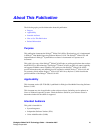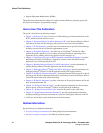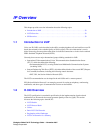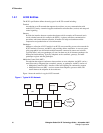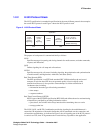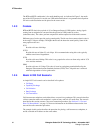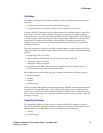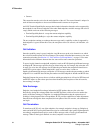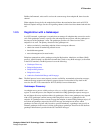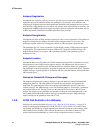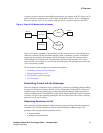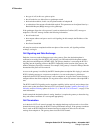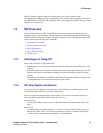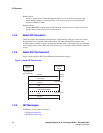Dialogic
®
Global Call IP Technology Guide — November 2007 33
Dialogic Corporation
IP Overview
Call Setup
Establishing a call between two endpoints nominally requires two TCP connections between the
endpoints:
• one TCP connection for the call setup (Q.931/H.225 messages)
• one TCP connection for capability exchange and call control (H.245 messages)
In practice, the H.245 channel may not be required thanks to two additional features of the H.323
protocol. H.323 version 2 defines a Fast Start mode that accomplishes the endpoint capability
exchange through the use of Fast Start Elements (FSEs) which are “piggy-backed” on Q.931/H.225
call setup messages rather than waiting for an H.245 channel to be established. It is also possible to
encapsulate H.245 media control messages within Q.931/H.225 signaling messages using a
technique known as H.245 tunneling. If tunneling is enabled, one less TCP port is required for
incoming connections.
The caller at endpoint A connects to the callee at endpoint B on a well-known port, typically port
1720, and sends the call Setup message as defined in the H.225.0 specification. The Setup message
includes:
• message type; in this case, Setup
• bearer capability, which indicates the type of call; for example, audio only
• called party number and address
• calling party number and address
• Protocol Data Unit (PDU), which includes an identifier that indicates which version of
H.225.0 should be used along with other information
When endpoint B receives the Setup message, it responds with one of the following messages:
• Release Complete
• Alerting
• Connect
• Call Proceeding
In this case, endpoint B responds with the Alerting message. Endpoint A must receive the Alerting
message before its setup timer expires. After sending this message, the user at endpoint B must
either accept or refuse the call with a predefined time period. When the user at endpoint B picks up
the call, a Connect message is sent to endpoint A and the next phase of the call scenario, capability
exchange, can begin.
Capability Exchange
Call control and capability exchange messages, as defined in the H.245 standard, are sent on a
second TCP connection. Endpoint A opens this connection on a dynamically allocated port at the
endpoint B after receiving the address in one of the following H.225.0 messages:
• Alerting
• Call Proceeding



